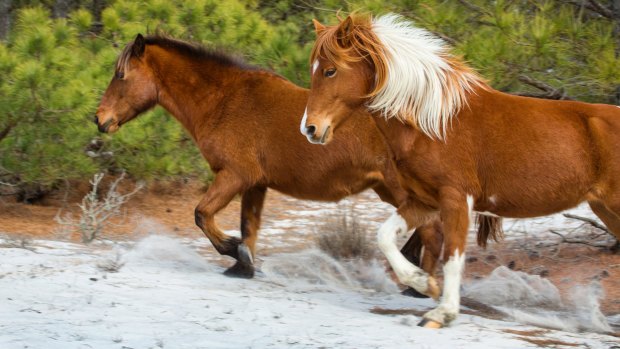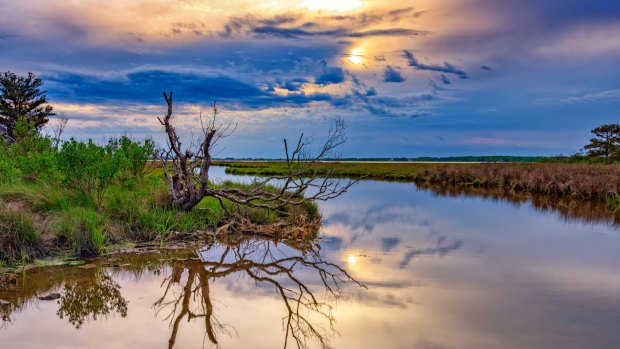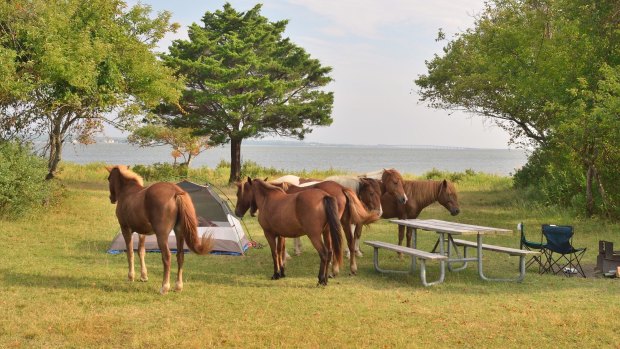This was published 6 years ago
How to see the wild horses of Assateague Island, USA
By Julie Miller

Two of the wild horses at Assateague Island National Seashore in eastern Maryland, USA, run through open, sandy woods. Credit: iStock
A band of horses trots over a sand dune, headed for the shoreline to escape the torturous sting of summer bugs. Led by a handsome bay stallion with enviable black locks cascading over his arched neck, 11 pinto and chestnut mares and foals buck and frolic past sunbathers, who step back cautiously to let them pass – these are, after all, wild animals, with unpredictable behaviour and attitude befitting the rock stars they are.
As a 50-odd-year-old woman who never outgrew my "pony phase", I am captivated as I watch the legendary horses of Assateague, a sandy barrier island stretching between Maryland and Virginia on the windswept east coast of America.
Like many of my generation, I grew up with the story of Misty of Chincoteague, a classic children's novel written by Marguerite Henry that told the story of a wild foal adopted by local children; so for me, this is somewhat of a pilgrimage, the opportunity to finally see the creatures that sparked my imagination and set me on a horse-obsessed path of no return.

The sun sets over the marshlands and Chincoteague Bay, Assateague Island.Credit: iStock
I'm not alone in my adoration – the ponies are one of the biggest drawcards of the region, luring hundreds of thousands of tourists each year, with up to 50,000 people alone attending the Pony Swim festivities held in the small town of Chincoteague each July. The horses even have their own fan club, complete with apps and swap cards sharing details of their bloodlines and the most likely places they can be found in their island sanctuary home.
Feral horses have inhabited Assateague Island for more than 400 years. While local legend has it that the original inhabitants swam ashore after a Spanish galleon was shipwrecked during a ferocious storm, a more likely – though far less romantic – theory is that islanders let livestock loose on the island to avoid taxes. Whatever their origin, these hardy creatures have adapted to the mosquito-infested, sun-blasted environment, thriving against the odds on the salty, nutrient-poor grasses of the marshes and dunes.
There are two herds on Assateague Island, separated by state lines: the Maryland herd currently has 89 horses, managed by the National Park Service; while the southern herd of 150 ponies graze on Chincoteague National Wildlife Refuge land, but are actually owned by the Chincoteague Volunteer Fire Company.

These Assateague or Chincoteague ponies gather around a campsite.Credit: iStock
The National Park's approach for the northern herd is minimal intervention – they are managed like other wildlife, with the only interference the administration of contraception to keep numbers to a sustainable level. The ponies have free range of the National Seashore territory, including the beach where they tend to hang out during the heat of day.
It's a thrilling sight to watch the horses playing amongst the breakers; but while the National Park's approach may be "hands off", instilling that concept into the minds of the general public presents a constant challenge. With the horses habituated to humans, they show little fear as they wander along the shore and through campsites, bold and inquisitive. And while they may look as cute as My Little Pony, tourists who recklessly reach out to pet them often find themselves on the wrong side of a kick or potentially rabid bite.
Meanwhile, south of the border, the Virginian herd are isolated from the public, grazing behind fences on the Chincoteague National Wildlife Refuge, which is largely accessible only on foot. While this means viewing opportunities are limited, this system of management is in many ways more intrusive, based on nearly century-old traditions.
Since 1924, the Chincoteague Volunteer Fire Department has maintained the health of the herd with regular vet checks, vaccinations, hoof trimming and supplementary feed during winter months. These horses are allowed to breed as nature intended; but to control numbers, foals are sold at auction during the annual Pony Penning festival, an event that raises up to $150,000 for the self-supporting fire department.
The highlight of the week-long festivities is the Pony Swim, where the herd is swum across the channel between Assateague and Chincoteague by local "Saltwater Cowboys", cheered on by crowds of fans. The foals – around 50 each year – are then sold to the highest bidder, with half a dozen returned to the herd as "buy backs" and the rest transported away for a new life as domesticated pets.
While this event has its detractors (with many believing the foals are too young to be separated from their mothers), the Pony Swim is a beloved tradition for the people of Chincoteague, as well as a sentimental favourite amongst horse lovers whose lives have been shaped by childhood dreams of these irrepressible symbols of the wild.
FLY
Air Canada flies to New York City via Vancouver on a daily basis, see aircanada.com. From NYC, it's a four-and-a-half-hour drive south to Ocean City, Maryland, or three hours from Washington DC. For car rental, visit Driveaway Holidays at driveaway.com.au
STAY
The Edge Hotel at Fagar's Island in Ocean City has waterfront suites starting from US$219 in off-season and US$390 in the summer. See fagers.com/hotels/
Julie Miller was a guest of Worchester County Tourism.
Sign up for the Traveller Deals newsletter
Get exclusive travel deals delivered straight to your inbox. Sign up now.